In 1984, Syria witnessed one of the largest “looting” operations in its history. The target was not a house, a warehouse or a factory. It was the entire central bank.
Rifaat al-Assad looted the contents of the Central Bank of Syria following the famous dispute between him and his brother, Hafez al-Assad, before leaving for France, where he built his financial empire at the expense of all Syrians at once.
Rifaat’s deed was not “a burglary”, which requires secrecy and concealment attempts, but was rather a case of overt “looting”, and a robbery that did not require justification or concealment, passed in silence without being registered, and proceeded without any reaction or accountability.
Before that, the “Defence Brigades,” the military force led by Rifaat al-Assad, practiced the most blatant forms of “looting.” The forces were given several lands on the outskirts of Damascus, which turned into “random colonies” after they were emptied of their inhabitants and the properties of old houses were looted. This happened in neighbourhoods like “Mezzeh 86” and “Mezzeh Khazan”.
Hafez al-Assad’s rule was characterized by various forms of looting, which targeted different areas in Syria and reached Lebanon, where the Syrian army vehicles, until the beginning of the last decade, came out across the border loaded with electrical appliances and home furniture.
The “old shabihah,” who are the “looters” of “Shabah” cars from the regime officials’ militants, have also carried out robberies by force of arms since the 1970s, carried out illegal looting, and even had the green light to carry out mass “looting” operations.
This phenomenon has been monopolized by al-Assad regime for 40 years, but it developed into a custom for the conflicting forces following the outbreak of the Syrian revolution. Since 2012, armies, militias, and various military factions have been involved in “looting”, which has become one of the aspects of war in Syria.
From phenomenon to custom … “Looting for all”
The “Altafish” (looting) is a term that appeared in the second year of the Syrian revolution (2012), after it transformed from peaceful manifestations to armed action, when the Syrian regime pursued a policy of bombing then invading cities, and plundering the remaining movable property. This practice later became a systematic policy that went beyond its “linguistic meaning” and became a common custom associated with military battles and operations, once completed.
There has been much talk about “looting” over the past seven years. The phenomenon was mainly related to al-Assad forces and the militias supporting them, which were the first to commit thefts and looting after the fighting, especially the “National Defence” forces, which followed plans and methods that were implemented immediately after taking control of neighbourhoods and cities.
| There is no synonym for the word “Altafish” in Arabic. It is a term commonly used in Syrian dialect with the root “home furniture” (Afsh) and all the related equipment and property within houses, shops, factories, warehouses and goods. |
An “organized strategy”
The “looting” charges against the Syrian regime have not been established arbitrarily but on the basis of incidents of robberies and theft carried out by the “Syrian Army” soldiers in Syrian cities, and it is the soldiers themselves that used this term.
Homs province was the first of the areas where the “looting” operations were implemented after controlling the city of al-Qusayr and its surroundings in the western countryside, which was previously known for the abundance of agricultural machinery in addition to the workshops and their accessories, from motors of pumping water and networks to irrigate crops.
Al-Assad forces gained thousands of dollars after taking full control of the area in 2013. These fortunes were distributed on personalities and militias particularly active in pro-regime villages west of the city.
A few months later, the battles moved to Homs city of which the regime took control in 2014. This resulted in considerable progress in favour of the regime forces, both militarily and financially. Such a progress is enhanced by the theft of furniture and household furnishings items such as electrical wiring and water networks.
These practices then developed into opening markets in pro-regime areas for selling stolen goods. Following the previous developments, “looting” was transformed from a random operation of most of al-Assad forces militants into a phenomenon associated with influential individuals, mostly paramilitary militia leaders. The robberies were divided into stages according to the influence of the people working in them.
Not only Homs houses were looted, the town of Darayya, in the western countryside of Damascus, was completely looted, too. In addition, the eastern Aleppo neighbourhoods and the entire western countryside of the city of Damascus, and recently the eastern Ghouta, especially the city of Harasta, were targets of looting and robbery there began just few hours after the exit of the fighters. Looting even reached the towns and neighbourhoods in south of Damascus.
Over the past years, the Syrian regime has overlooked the various robberies and “looting”, documented by al- Assad forces, with video recordings and photos widely circulated on social media sites. Besides, the regime’s widely distributed barriers have facilitated the passage of stolen items, despite their large size and the large mechanisms required for their transfer.
Opponents view the regime overlooking of the phenomenon as a reward for its militants for their military achievements, which they provided in the control of the regions. It is also a financial incentive to push the military forward to the next front without hesitation, hoping for more stolen items and furniture they will bring.
In the meantime, the “looting” phenomenon was linked to the Syrian regime intention to punish its opponents and civilians who opposed it. It aimed at making them loose any “hope” to return, and transmitting them the idea that they are the most vulnerable while the regime’s fighters are the most powerful.
https://youtu.be/FLj_5OsZG2g
The video presents a pro-regime journalist’s shock while “Shabiha,” Assad’s forces, looted his house
“Free Army” factions looted Afrin
The Syrian regime’s policy of robbing in Syria cannot be compared with the other parties. Despite the spread of the phenomenon to the other parties of the conflict, it has been to a lesser degree and at different periods.
The area of Afrin was the most obvious example of the “looting” carried out by the “Free Army” factions. After the takeover in February, the social networking sites were invaded by photos and recordings showing militants of the military factions stealing in the city of Afrin after entering and controlling it completely.
The images were broadcast by activists from the Aleppo countryside who accompanied the fighting, as well as international agencies including AFP, which published dozens of photos of militants stealing house furniture and shops as well as motorcycles and tractors. This caused widespread anger that has evolved into demands for accountability of militants, as these practices are not different from the other forms of abuse by the rest of the military forces in Syria.
Earlier, Enab Baladi talked to the spokesman of the National Army, Mohammad Hammadin, who said that the practices which are talked about were known previously. Each army’s entrance to an area is accompanied by “individual abuses” by its militants.
“Units’ looting” away from the media
The “People’s Protection Units” (Kurdish) affiliated with the “Syrian Democratic Forces” were accused of stealing the houses of Raqqa people after its full control, late last year.
These thefts were not documented, as was the case with the regime and the opposition, and the “Units” stayed completely away from the media spotlight, unlike the regime, which was famous for its practices through videos published from time to time.
However, activists have documented part of the “looting” in the “Units’” areas, most notably a video posted in November 2011 showed trucks and Syrian Democratic Forces (SDF) militants, as well as a warehouse which contains a big number of gas cylinders in the city of Raqqa.
The deputy head of the local council of the province of Raqqa, affiliated with the interim government of Syria, Mohammad Hijazi accused SDF of “looting” the equipment of public hospitals and transferring them to the north of Raqqa and to the city of Ayn al-Arab (Kobani).
Operating networks in the Eastern Province, including “Raqqa is Being Slaughtered Silently” documented looting incidents carried out by SDF, including the sale of the contents of the industrial zone in Raqqa, which amounted to one and two hundred million Syrian Pounds. It included auto spare parts, industrial equipment, and machinery.
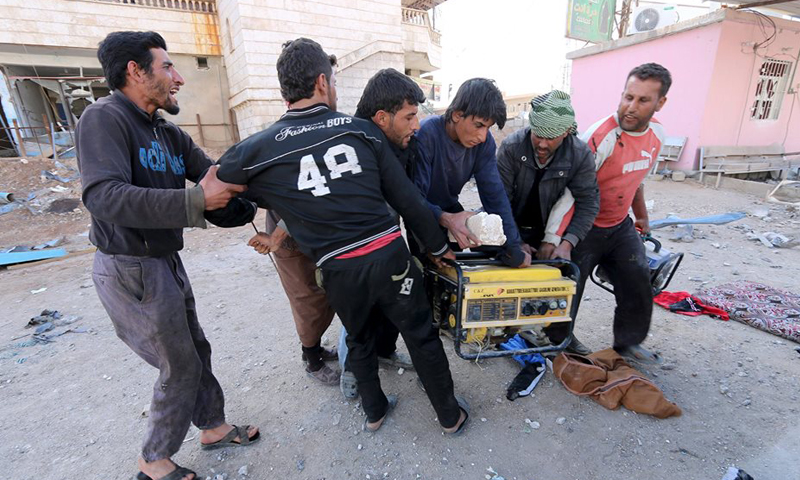
A group of people fighting over a looted electricity generators in Al-Shaddadi city, February 26, 2016 (Reuters)
Railways and “loot” in the north
The “looting” in Idlib province in the north of Syria had a different direction, and although it fundamentally differed from the general image followed by the Syrian regime and other parties to the conflict, it was classified as theft and looting in order to obtain additional resources.
Since the Islamist factions took control of Idlib in 2015, some of them have been accused of stealing service institutions that were previously founded during the Syrian regime’s control, including the National Museum in the center of the city, in addition to the railway in the western countryside, which was controlled by “The Turkistan Islamic Party” and “Hay’at Tahrir al-Sham”.
In April 2016, Enab Baladi documented members of the Turkistan Islamic Party selling of the Zeizoun Power Station holdings, located in al-Ghab Plain in the western Hama countryside, in the region market. According to the sources, the Turkistan Islamic Party in Syria had earlier restored the bridge of Halfaya in the northern countryside of Hama, after being damaged by warplanes bombings, using disassembled iron from the rails, and used iron to support the bridge on the Latakia highway, which was completely destroyed and reformed by the Turkistan Islamic Party.
The most noteworthy “looting” actions were in February when activists on social media websites posted pictures of the remains of a helicopter carried on a truck in Idlib.
According to relevant information, large cargo vehicles loaded with aircraft spare parts and remnants left Taftanaz Military Airbase, which is controlled by Hay’at Tahrir al-Sham, and headed towards the regime-controlled areas.
Some suggested that Hay’at Tahrir had sold aircraft remnants as scraps to the Syrian regime, which caused the anger of activists, as these aircrafts were bombing civilians.
This was not limited to the aforementioned, the military factions had reciprocally looted each other’s military equipment, especially during the recent clashes between Harakat Ahrar al-Sham and Hay’at Tahrir al-Sham. The latter took control of one of Ahrar al-Sham’s military camp which contains tanks and military vehicles, and they have been included as part of the so-called “spoils of war”.
Official recognition
“A pretext much sillier than the mistake”
The phenomenon of “looting” has been addressed on social media websites and in the talk of opposition activists following each control of al-Assad’s forces over new opposition areas, without any recognition or statement by the Syrian regime, or legal action against the thieves.
However, over the past months, the issue has taken a different turn, through its inclusion within the discussions of the People’s Assembly, Russia’s interference to combat it and the penalization of members of al-Assad’s forces.
The phenomenon had initially and officially been addressed by the president of the Syrian regime, Bashar al-Assad when he admitted the spread of the occurrence of “looting” in the ranks of his forces’ affiliated militias, especially after the events that took place in Aleppo in late 2016, and the robbery and looting of dozens of houses and shops.
In an interview with a pro-regime al-Watan newspaper in January 2016, al-Assad said that the phenomenon of “looting” depends on “the conscience of the people in the first ranks of the battles. There is no supervisor, no police, and no supervisory institutions. If this person is corrupt, he would harm the citizen, and if he is with a conscience he would do the opposite.”
“There are cases that have been controlled despite the difficult circumstances of the battle. They have been controlled in the back lines after the arrest of a person who committed abuse or robbery of any form. There are cases that have been controlled and I know them in detail, but there are other cases that have not been controlled,” he said.
Al-Assad raised the attention of his officers and the concerned parties to the need to end this situation, and pointed out that there are measures to prevent any possible. In addition, accountability is based on the available possibilities everywhere.
Over the past months, the phenomenon has been increasingly discussed by pro-regime media and websites. In April, MP Tarif Qutrash criticized the phenomenon, especially after the displacement of the inhabitants of Eastern Ghouta from their homes.
Qutrash confirmed that the cases of “looting” have increased after al-Assad forces’ entry to Harasta. He said: “We see ugly scenes on the Damascus-Homs Highway, including the sale of beds and other things.”
Qutrash’s speech did not receive any response from the Council’s head or members, as from the opponents’ point of view, he was addressing an issue that is beyond the Council’s authorities.
Nevertheless, the shocking response to the phenomenon had occurred on 26 May, when Russian military police arrested a group of members of al-Assad’s forces after committing a robbery in the town of Babbila in the south of Damascus, and forced them to lie down on the ground.
The situation had raised the anger of al-Assad supporters and wide reactions, which pushed the Ministry of Defence in the Syrian regime government to justify what happened by claiming that those who appeared in the photos “are absolutely not soldiers from the military institution. They do not belong to it, they are wanted by the security authorities, and their names have long been circulated in all barriers.”
However, the page of the Central Channel of Khmeimim Air Base confirmed that the Russian forces do not allow violations in the liberated areas with their participation. “Members of one of the ground combat teams that violated the law have been arrested in areas in the south of the capital Damascus.”
It also stressed that “any rebellion by individuals that are involved in the violation of the law and those who support them in the liberated areas with the participation of Russian forces will be dealt with by force.”
Russian Soldiers arresting members of the regime forces for looting
Opinion poll: Political leadership in Syria is responsible for “looting”
Enab Baladi conducted an opinion poll on its website and Facebook page to find out the readers’ points of view about the responsible party for the spread of “looting” in Syria.
The opinion poll’s question was as follows: “In your opinion, who is responsible for the “looting” practices following the displacement of the population and the evacuation of the cities in Syria?”
52 percent of the respondents considered that the political leadership of the Syrian regime is responsible for the “looting” actions.
27 percent of the respondents considered that members of the army and the affiliated military forces were responsible for the matter, while 21 percent considered that the field commanders are the most influential party in the spread of cases of “looting”.
Poverty paves the way to “looting” practices
Before the outbreak of the revolution, markets where stolen goods are sold have been spread in Syria. These markets are called “Souqs al-Haramiyah” (robbers market). They have been selling stolen or used furniture and tools. However, most Syrians used to avoid buying any goods from there, for both religious and moral motives.
After the revolution, the deterioration of the economic conditions helped opening the door of “looting”, both in terms of carrying out robbery and disposing stolen goods, as a profitable business for the poor seller and satisfying for the poor purchaser.
Many members of the regime take advantage of military advances to steal the contents of houses in the controlled areas in an effort to gain some financial profit, as the military officer may earn five or six times his monthly salary at a single selling operation.
The salary of the military officer in the regime’s forces is 14 thousand Syrian pounds, plus ten thousand pounds if he serves in an area of combat. The salary increases after the officer’s entry in retention and reaches about 40 thousand Syrian pounds (between 20 to 100 US dollars).
The salaries of opposition combatants are close to those of al-Assad’s forces. They reach between 40 and 100 dollars in Idlib and Daraa, and increase more for the fighting factions in the eastern regions.
Thus, the ordinary combatant cannot afford his day living or support his family. The Syrian family needs an average of 200 thousand Syrian pounds to secure its needs, which means five times as much as the salary of the combatant. Therefore, this widely opens the choice of robbery which becomes legitimized under the label “spoils of war”.
On the other hand, the average income of the Syrian citizen is 40 thousand Syrian pounds, which is a small amount compared to the high prices of goods in the markets. This forced many citizens to break the barrier of purchasing stolen devices, as their prices do not exceed a quarter of the prices of new devices
Looting or spoils of war?
With all Syrian parties’ committing “looting”, the regime is the most accused party of largely practicing it, outlawing with this the Syrian laws that are supposed to be applied by its members before others, and ignoring the international laws that criminalize robbery in wars.
Although the Syrian Penal Code is applicable in the case of unlawful seizure of property, many of those whose belongings and properties were stolen tried to sue security agents and government officials for “looting”, but in vain.
“Looting” is a war crime in the international law
Ibrahim Alabi, the director of the Syrian Legal Development Program (SLDP), explained to Enab Baladi that many people are not aware that International Humanitarian Law is the reference in the investigation of the looting crimes that take place in times of conflict, because they think that “this law is addressing only fight crimes between the conflicting parties.”
According to the theories of criminology, when a criminal repeatedly commits a crime, he becomes accustomed to it and starts considering it as a common behaviour. That’s exactly what happened to those individuals, who got engaged into conflicts and fought in the front lines.
As opposed to the common rule of theft, which urges thieves to steal “the lightest yet the most expensive items”, al-Assad forces have been accustomed to emptying the content of houses, including water taps, power cables and even bathrooms ceramic tile. This has become evident after the displacement of the residents of the rebellious areas such as Darayya and Ghouta, and finally Yarmouk camp.
Despite the regime declaration of the end of military actions in some areas, they are still classified as areas of armed conflict according to “international law”. Therefore, the behaviours of the conflicting parties are still subject to “International Humanitarian Law”.
The conventions and protocols of international law identify “looting” as a war crime, for The Hague Convention prohibits looting under any circumstances.
International law discriminates between military equipment owned by the adversary and the properties of homes and laboratories. Article 50 of International Humanitarian Law prohibits the destruction or seizure of the property of the adversary except in cases of military necessity while article 49 of the same law allows the parties to the conflict to seize the military equipment of the opposing party as spoils of war.
International Humanitarian Law dealt with the human right to protect one’s property in article 111 and 113 which respectively protected the property of the wounded and shipwrecked, and the dead against looting or mutilation of their bodies, while article 122 protected right of the detained against looting, too.
The Regime accountability cases are increasing
The regime identifies this crime as “individual acts”, denying the responsibility of its leaders for such activities, but the Rome Statute highlights the International Criminal Court jurisdiction and ability to make decisions about crimes of seizure of individual property. These practices constitute a serious violation of the 1949 Geneva Conventions, especially in case they were committed within the framework of a plan, a policy, or a large-scale operation. Therefore, the leadership will be responsible for these acts because it did not prevent its members from committing such crimes.
Commenting on the use of the international law’s incrimination of such acts committed by al-Assad forces, al-Albi said that “despite the absence of accountability, it is necessary to incriminate the looting acts committed by al-Assad forces, because it is better to have a law to be violated rather than allow such behaviour. This adds another file to the cases of accountability to be documented by international organizations and prove the criminal aspect of the Syrian regime during and after the fighting.”
Sharia Rule concerning the purchase of looted goods
The Syrian Islamic Council, which includes about 40 Syrian associations and Sharia committee, issued a statement in March 2018 stating that “looted or forcibly stolen” are “haram” and any purchase, sale, or ownership of such property is forbidden unless the buyer recognized it to be his own or bought it to give it back to its original owner.
In justification of this statement the Council stated that “looted or forcibly stolen” goods are still the property of the owner and that the seller needs to own the goods in order to sell them or else the sale process will not be legitimate. Besides, property does not belong to the thief or the one who bought it, since the original owner did not give the thief permission to sell it or put it under his disposal.
The statement identified the act of purchasing such goods from these “robbers” as being supportive of sin and enmity and encouraging the criminals to steal money and loot property.
The fatwa of the council allowed the purchase of the property, which source is unknown, having only two exceptions. If there is strong evidence that the exhibited goods are stolen, then the purchase and sale are not allowed. In case the source of the goods is unknown then purchase and sale are forbidden, too. Banning should be a prior rule for distinguishing between looted and owned property is very difficult amid the prevailing atmosphere of robbery and chaos in this country.
The statement has been concluded with the recommendation addressing those who purchased of some of these stolen or looted goods, to repent to God, and return them to their owners, or hand them over to the authorities responsible for those areas so that they could bring them back to their owners.
The council also recommended these authorities to take the stolen properties back and deliver them to the owners in every possible way. If the owners are not aware of this and the authorities have done their best looking for the owners, then these goods will be given to charity and to the needy and the poor. This process needs to be restricted and documented by papers and pictures. In case the owner showed up again, the authorities will be responsible for refunding him, either through providing the same goods or refunding their value.
Whoever buys a property that he thinks is “halal” and then turns out to be stolen must return it to its owner. In this case the seller shall return the money to the buyer. However, in case the person lost his properties because of war or a robbery then that’s a state of calamity that requires patience. Therefore, he is not allowed to redeem that loss through taking someone else’s property or buy stolen or forbidden goods.
The Fatwa of the Council matched the statement of Sheikh Fathi al-Safi, whose lectures and “fatwas” are broadcast through pro-regime media outlets. He considered that even if a person is poor, he is not allowed to buy stolen goods. He pointed out that he is not allowed to buy the exposed goods even if they were “confiscated”, let alone if they are stolen.
Markets of looted goods take over pavements in Syria
With the increasing operations of looting, there was growing need for markets where military groups could sell what they have stolen, including furniture and second-hand household appliances. This process turned pieces of junk into banknotes that filled the pockets of the new “traffickers”.
For this purpose, some of the cities’ pavements in Syria have been turned into “looters’ markets” characterized by a remarkable commercial movement. These markets are known for the amount of looted goods they exhibit. The purchasing movement of each market depends on the marketing of the stolen goods with each military operation of al-Assad forces.
Homs
In the city of Homs, the market has gained the greatest fame in terms of idea and origin, in addition to its sectarian name “Souk al-Sunnah”, in reference to the materials sold inside and the source of the looted goods and even the way it was sold to the Sunnis. Souk al-Sunnah is located in Wadi al-Dahab in the centre of Homs and is spread along the two sides of the road near the Tishreen swimming pool.
Damascus
Hay al-Homsi neighbourhood located in the area of Jaramana on the outskirts of the capital Damascus, is one of the most famous and largest markets for looted goods in the city. It has witnessed a recovery when al-Assad forces took control of eastern Ghouta. In addition to Hay al-Homsi , Souq al-Duwayliah is close too and is located near al-Kabbas Bridge. The regime forces removed this market because of the huge amounts of looted goods and troubles it caused in the area. This market was then transferred to Kashkul in eastern Damascus, which is competing with the looted goods market in Mezzeh 86 in western Damascus. This area is considered as the headquarters of the Shabiha, who are fighting along al- Assad forces and who have the priority to loot the houses.
Souq al-Haramiya near al-Thawra Street in central Damascus has also been active and selling looted goods. This market has a bad reputation for the suspicious or stolen material it has been selling since the 1990s, but the type of the goods sold in this market has been reflected on the nomenclature, materials, and purchasing movement.
In the current year, the looted goods market in Dahiyat al-Assad, has witnessed a large recovery after the military campaign on eastern Ghouta. This market spread along Dawar al-Dahia to the suburb of the junction to the cross-roads of al-Kadmous Transportation Services. The market is famous for the bulk of goods, which are stolen from eastern regions of Ghouta, especially Harasta, which is adjacent to the suburb. It contains all kinds of furniture, electrical appliances and other materials, including copper electricity wires pulled from the walls of houses in Harasta. However, national security forces quickly raided the market and confiscated the goods exhibited on the pavements and roads, and arrested the perpetrators, after the residents of al-Dahia have complained more than once about the existence of a market for looted goods in the region.
Deir ez-Zor
The market for looted goods in Deir ez-Zor is located in al-Wadi Street in the centre of the city. It has witnessed a rush at the level of materials and purchasing movement on different intervals. It also contains a wide variety of household appliances and furniture, as well as foodstuffs.
Aleppo
The most important markets of looted goods in Aleppo are located in al-Razi neighbourhood in the area of al-Jamelaiah in the city centre. It is characterized by low prices and the intensity of sale and purchase movement. This market, which is called by city residents as “Souq al-Haramiyah,” spreads along the corner of al-Razi Bridge to the vegetables market.
Next is al-Faydh market, which extends from Bustan al-Zahra neighbourhood to al-Faydh with an estimated length of 500 meters. This market is full of sellers’ shacks and stolen tools scattered on the pavements. The prices of the goods are competitive, which stimulates purchase movement in the market.
The third market for looted goods is located in al-Hamdaniya District in the centre of Aleppo. It is well-known for its reputation and size. As a result of the large number of complaints against it, al-Assad forces closed it after hundreds of charges were filed against it owners, who were accused of looting the other neighbourhoods in Western Aleppo.
Outside the city, the village of Jibreen in east Aleppo has witnessed a large market full of items, which have been stolen and looted from eastern Aleppo during the Russian campaign.
Latakia and Tartus
The markets for looted goods have been spread along the streets and districts of the cities of Latakia and Tartus, the most famous of which is the popular market in the middle of Latakia. Al-Assad forces were known best for transferring the best of their looted goods to these two cities in the wake of each military operation in Syrian districts.
Raqqa
The village of Ghanim al-Ali in northern Raqqa was famous for the looted goods market, which was opened by al-Assad members for the sale of stolen goods from the towns and villages and countryside of Deir ez-Zor.
if you think the article contain wrong information or you have additional details Send Correction
النسخة العربية من المقال
-
Follow us :
Most viewed
- Intentions for popular resistance amid Israeli escalation in southern Syria
- Al-Sharaa names new Syrian government
- Kurdish Protection Units: Key point of contention between Damascus and SDF
- Syrians look forward to visiting graves of "martyrs" on Eid morning
- Syrian returnees celebrate first Eid after liberation











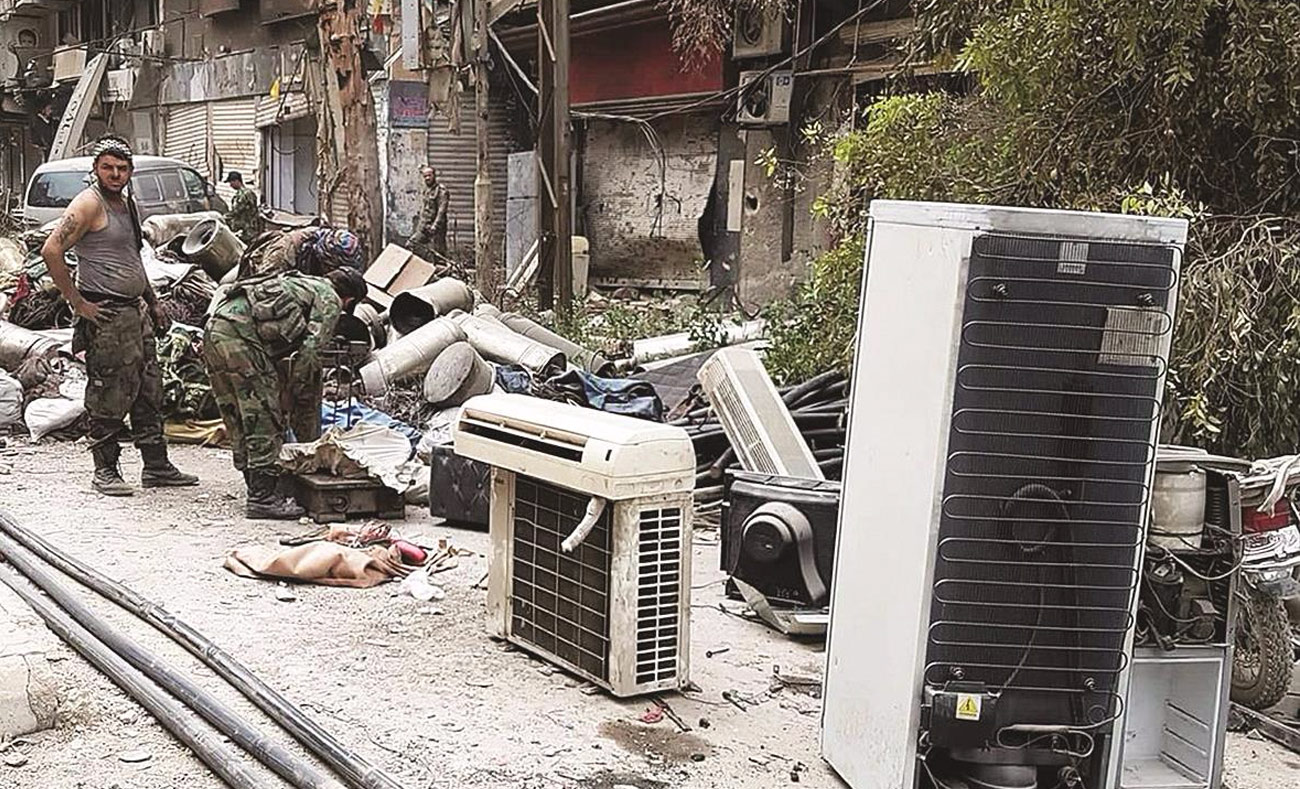
 Militants of the regime forces in Yarmouk Camp - 21 May 2018 (Internet - activists)
Militants of the regime forces in Yarmouk Camp - 21 May 2018 (Internet - activists)





 A
A
A
A
A
A

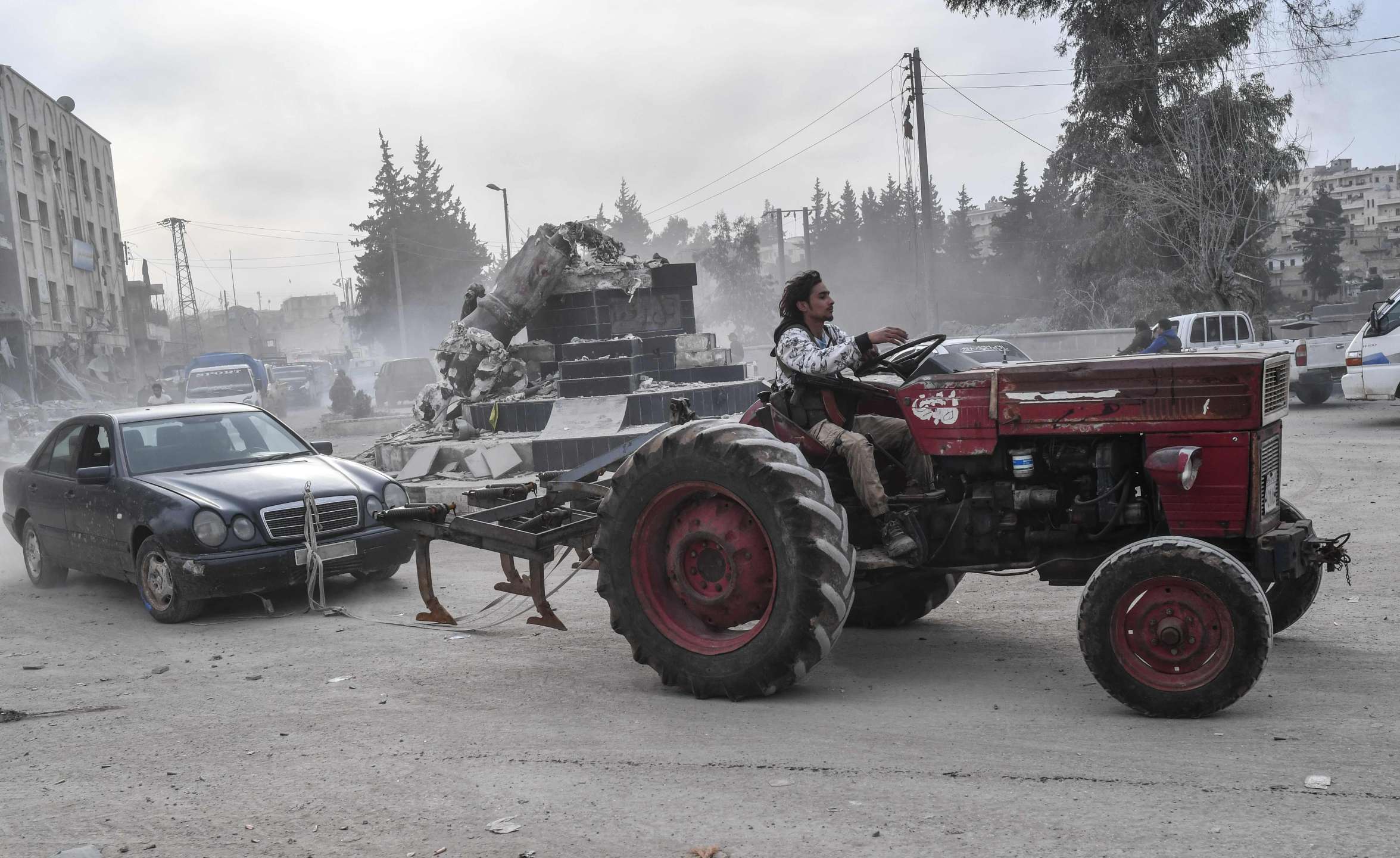

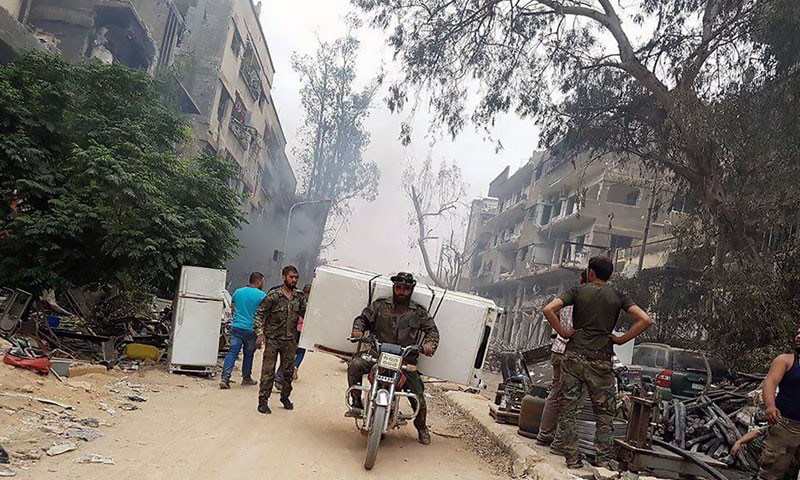






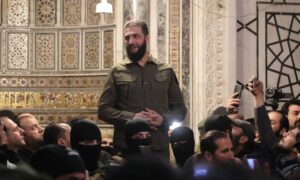
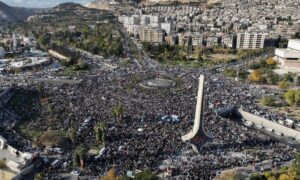
 More In-Depth
More In-Depth